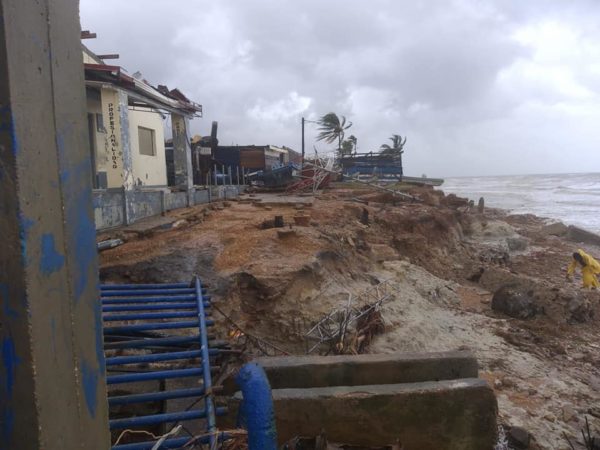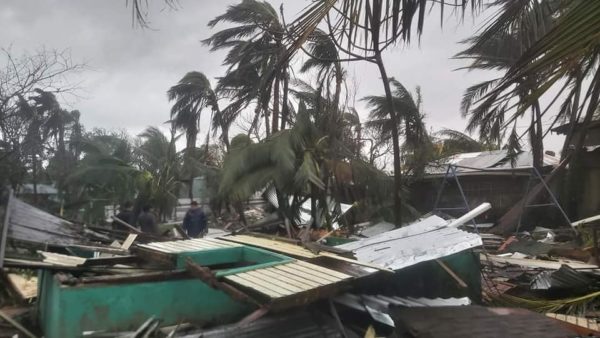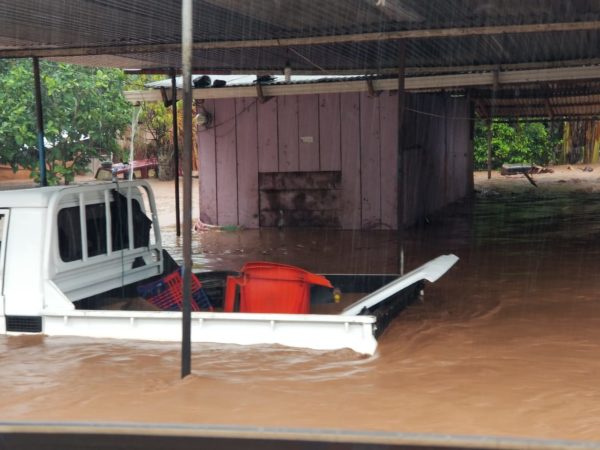The Day After Iota Hit Northern Nicaragua

Destroyed homes, isolated communities, roads in poor condition, and overflowing rivers are part of the damages recorded in the aftermath of the cyclone.
Por Ivette Munguía / Ana Lucía Cruz (Confidencial)
HAVANA TIMES – Where the Bilwi dock was, there are only scattered pieces of wood that the population has collected for reuse. The 250 kph winds generated by hurricane Iota on Monday night broke the important structure into pieces.
The roofs of houses are scattered in the streets, the phenomenon completely detached them and threw them several meters away. Residents said the houses were smashed like cardboard models and the wooden constructions disappeared among piles of rubble.
Two days after the initial Iota impact, Bilwi remains without potable water and electricity services. The telephone network is now reestablished. However, few people are able to communicate with the rest of the country because their phones are discharged.
Iota was the second hurricane to hit the North Caribbean of Nicaragua in the last 15 days. Some of the infrastructure partially damaged by Eta ended up succumbing to the force of Iota. Witnesses said the second hurricane was even stronger than its anterior.
It makes you want to cry
Meanwhile, in Bilwi it has not stopped raining, the remnants of the storm which is already in Honduran territory. Entire neighborhoods of the city remain flooded and a detailed report by the national authorities has not been possible.
Images posted by Radio Caribe show some brushstrokes of the city destroyed after the hurricane. The radio station is off the air, but it uses its webpage on the Facebook social network to convey the sorrow of the coastal population.

“As we anticipated the night of the fateful Iota, we were completely cut off from the rest of the world. Any native of the port who lives abroad would want to cry when they saw their people at this time. Nature has been cruel with our city,” the radio station emphasized.
A witness to the disaster said “the people are frightened, afraid, have suffered a lot, and very nervous.” “From outside the city there is no access, rivers have overflowed; and within the city there are brigades working to clear up the fallen trees and other debris,” added the citizen, who contacted Confidencial through a satellite phone.
“With Eta, many trees fell, some roofs were damaged, and communication and electricity cables fell. But with Iota there are many houses totally destroyed. Many other houses lost their roof and were severely damaged,” noted the executive of a private company in Bilwi.
The situation in Nicaragua
In the departments of Jinotega and Nueva Segovia, where Iota hit as a category 2 hurricane until it degraded into a tropical storm, the trail of destruction is Dantean. Overflowing rivers, flooded communities, houses washed away by currents, four dead and dozens of roads destroyed.
The deceased identified so far are: Maria de la Cruz Duarte, in the municipality of Quilali, in Nueva Segovia; Carlos Jose Lopez, Carlos and Francisco Carazo, in Wiwili, Jinotega, according to the November 17 report by Vice President Rosario Murillo.
The liberal party mayors of Yali, Murra and El Cua denounced, in an interview with Confidencial, that the lack of coordination and support of the institutions that make up the National System for the Prevention, Mitigation and Attention to Disasters (SINAPRED) persists, while they see how the number of people affected by Iota path increases.
The deputy mayor of Murra, Ninoska Cruz, reiterated that in that small community “they have no help from anyone.” She noted that everything they did before and during the first 24 hours of Iota passing was “on their own account” and “jointly with leaders who helped evacuate people in the outlying communities.” The worst damage registered was in communities located in El Milagro, El Rosario, Monte de Sion y Congoja.
“We have ten homes so far that the roofs came off, in addition to a house whose walls collapsed in the La Danta area. Another was destroyed in the Santa Julia community, in the municipality of San Gregorio,” explained the deputy mayor. So far only four families were moved to the shelters set up by the municipality.
Mayor Isidro Irias, from El Cua, said Tuesday they registered 131 families affected by structural damage to their homes. In addition, at least 60 kilometers of roads were damaged by currents, landslides or fallen trees. He said five bridges were washed away by rivers in Santa Maria, El Cano, La Lana and Vado.
Isolated Community
Mayor Noel Moreno, of San Sebastian de Yali, in Jinotega, explained that the municipality is without electricity service and lost communication with the Las Trozas community, due to the flooding of the rivers.

For now, Yali has only four families in shelters in the community of Las Ricas, while in the urban sector the people of La Bolsa and El Volcan neighborhoods have been affected. However, the mayor warned that much remains to be learned, because many leaders have not even been able to report.
In Wiwili of Jinotega, councilwoman Alba Marina Cardenas, confirmed serious flooding in the Puerto Lindo and Maleconcito communities. Images provided by the official show dozens of houses covered with water up to the ceiling in Puerto Lindo. In other videos filmed in Maleconcito, natural waterways completely overflowed, destroyed walls and entire houses in their path.
In San Jose de Bocay, the liberal political secretary Rene Garmendia reported serious damage to the municipality’s land communication. Some of the most affected areas, according to Garmendia, were La Pista, crossing of San Luis, La Bloguera and the micro-region of Ayapal.
In Jalapa, community leader Maria Elena Rivera reported damage to homes in the Los Placeres neighborhood, which were left without a roof. In Quilali; besides the death reported by Murillo, community leader Daniela Valenzuela reported damage to the homes in the Leonardo Gonzales neighborhood and the communities of Caulatu, Los Manchones and El Zunganlo, all nearby the La Danta creek.





